Petrol market’s smell
“Despite the poverty, one liter of Ai-92 petrol costs approximately US$1in Armenia. Thus, it is worth filling in petrol in Georgia, where that very Ai-92 costs approximately RUB 45. This is a quote from the article, entitled “How much travelling by car along Armenia will cost?, published by the Russian “Avtovzglyad Internet-portal. Konstantin Gusev, the author of the article, travelled to Armenia by his own car, naturally, through Georgia. Of course, he was to be surprised with a difference in petrol prices in Georgia and Armenia, all the more so as it is surprising even for us, the residents of the Republic of Armenia.
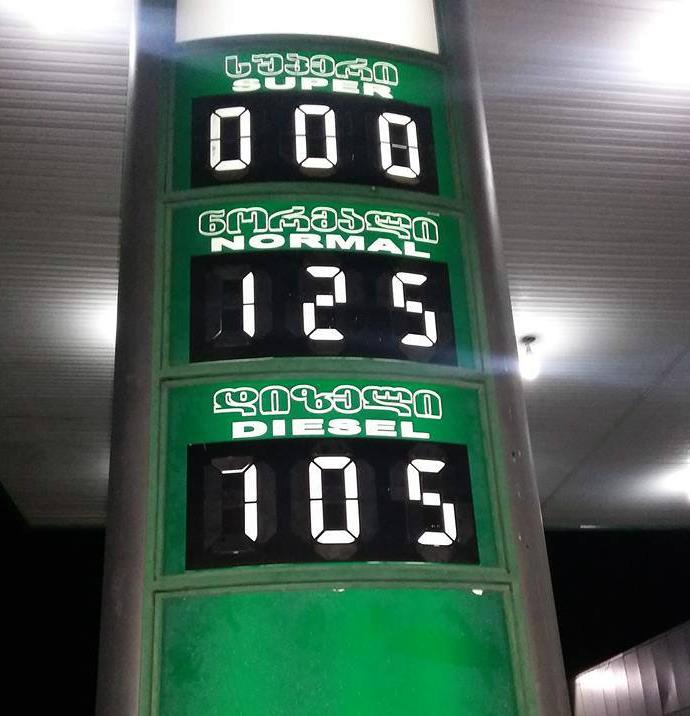
Photo by Tatul Hakobyan
Neighboring country factor
According to the data of February 4, one liter of petrol Regular in Georgia amounted to GEL1.38 (approx. US$0.55), Premium – GEL1.58 (approx. US0.63). As for Armenia, on the same day, petrol Regular cost AMD390 (US$0.78), Premium – AMD410 (US$0.82). The price for one liter of petrol Regular in Armenia was by AMD116 (US$0.23 cents) or by 42% higher than in Georgia.

So, why does it happen, given the fact that Armenia, alike Georgia, is the petrol and oil products importer country? This is the question that has been recently frequently asked, but there is no clear respond to it so far.
Having not waited for the response, Armenian drivers adequately react to the existing circumstances; they fill in their vehicles in neighboring Georgia. Don’t be surprised. This is elementary mathematics. If a vehicle tank can contain 60 liters and is filled in Georgia, AMD7000 – almost US$15 can be saved.
The drivers, residing in the vicinity of the Armenian-Georgian border, are not lazy and cross the border by their vehicle, let say, at least once a week. They fill in petrol at the nearest filling station, they may as well buy things for home (many goods, including baby diapers and laundry detergents, are cheaper in Georgia) and afterwards return home.
Oil factor
To be more precise, the lack of this factor. During the last year, the oil prices dropped twice, but the petrol prices in Armenia have not changed. It seems that petrol is obtained not from oil, but from tomato juice and the price for it is not linked to the oil price.
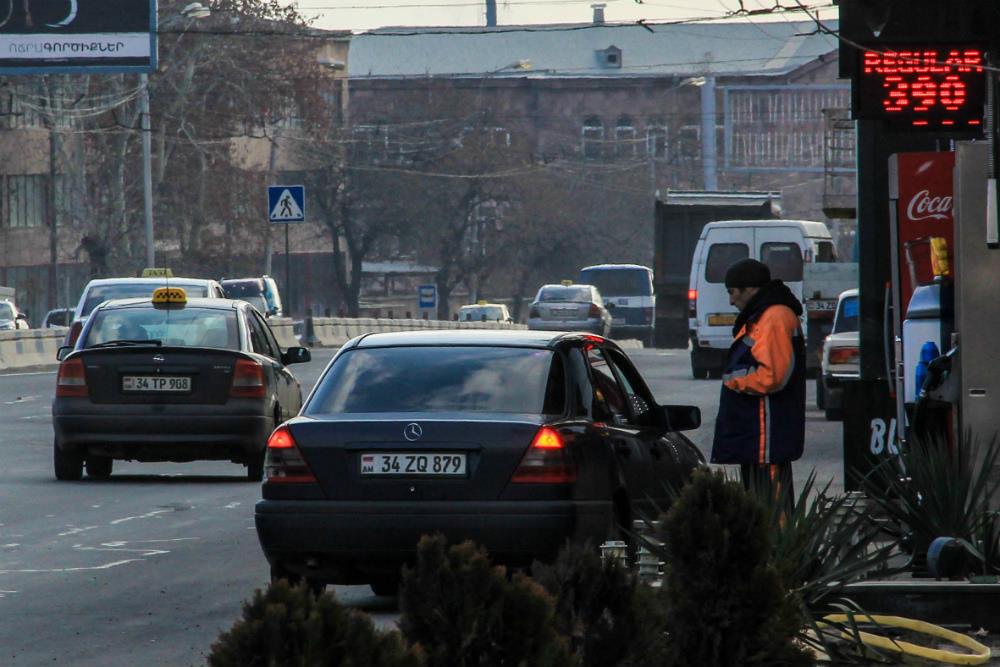
Artak Shaboyan, Chairman of the State Commission for the Protection of Economic Competition of RA (SCPEC), gave explanations on that issue. It turned out that the petrol price in Armenia is not linked to tomato juice, neither is it linked to oil.
As he said, oil specific weight totals 5-8% in the prices for petrol available in Armenia. “High taxes, costs for logistics and others influence the petrol price in Armenia. As a result, oil specific weight gradually drops, the official noted.
It means that the petrol price little depends on the oil price and each 10% drop of the oil price at the international market must result in a price drop for Armenian petrol maximum by 0.5-0.8%. Naturally, this logic must act in case of increase of prices for oil. In other words, if the oil price increases by 10%, the price for Armenian petrol should not increase more than by 0.8%.
Meanwhile, in February-March 2012, the petrol price increased by AMD50 in Armenia, that is by approximately 10%. The increase in prices could not be explained by the rate as the US Dollar rate remained unchanged during three months (AMD388-389). On March 30, 2012, when asked about petrol increase in Armenia, Artak Shaboyan answered: “There is a wide-scale increase in petrol prices at the international market and that, naturally, is reflected on prices in Armenia.
Thus, the oil factor in Armenia acts very selectively.
Inspections, inspections
Last time the petrol prices were discussed at the RA Government sitting, a few days ago (February 4). Artak Shaboyan presented to the Prime Minister the results of monitoring and survey of the diesel fuel and petrol market.
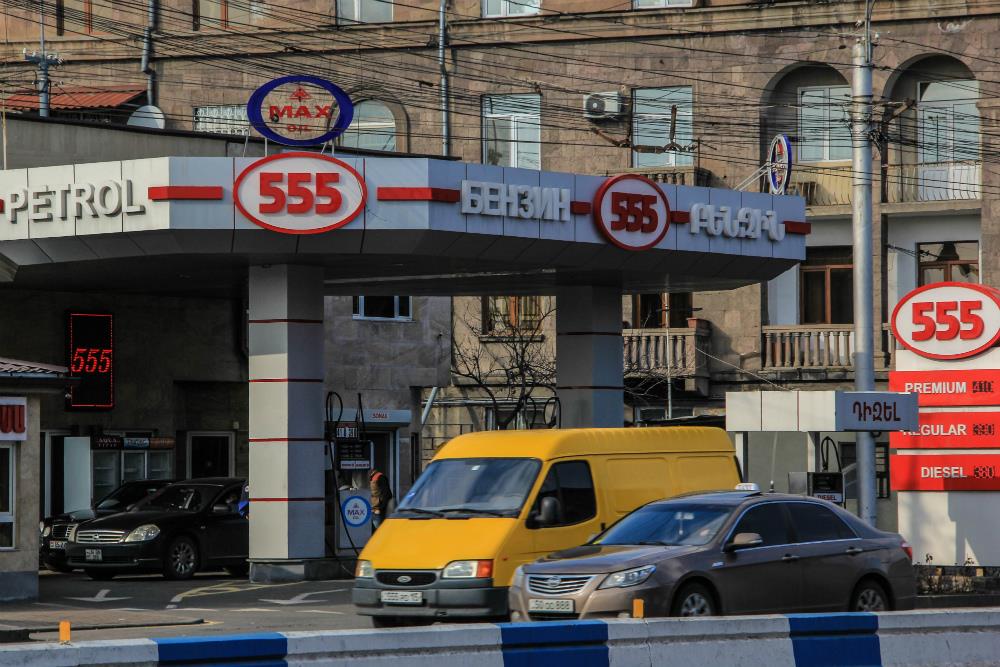
He still insisted that the oil specific weight in the final price for petrol in Armenia totaled approximately 8%. The Chairman of the State Commission for the Protection of Economic Competition noted that petrol was imported to Armenia mainly from Russia, where industrial costs totaled a high percentage of the prime cost, including high taxes. Besides, petrol transportation from Russia was associated with big expenses.
Despite the aforesaid, Artak Shaboyan noted that in 2015, the petrol prices dropped from AMD470 (US$0.95) to AMD390 (US$0.78). Moreover, considering 2014 data, the prices dropped even more – from AMD480 to AMD390. Furthermore, if one considers the situation in the past two years in US dollar terms, the petrol prices dropped by 28%. Moreover, petrol prices in Euro dropped by 14% in Armenia in 2015, in France – by 8%, in Germany – by 7%, in Italy – by 8%, in the Czech Republic – by 10%, in Romania – by 7%. In other words, if a concrete period of time is compared, the prices dropped much less in other European countries than in the Republic of Armenia. In other words, what the official wanted to say is: “So, what are you complaining for?
But the most surprising thing is that when mentioning other European countries, the neighboring Georgia was forgotten about.
Questions that remained unanswered
And still, why is petrol in Georgia much cheaper than in Armenia? Not so long ago, the interesting survey on that issue was conducted in Armenia. It turned out that a margin (a difference between the petrol price and the cost of its purchase, transportation and taxes) at the Armenian market was higher than in Georgia. In particular, a margin totals approximately AMD146 (US$0.30) in a final price per 1 liter of Premium petrol in Armenia, as for Georgia, it totals AMD101 (approx.US$0.20).
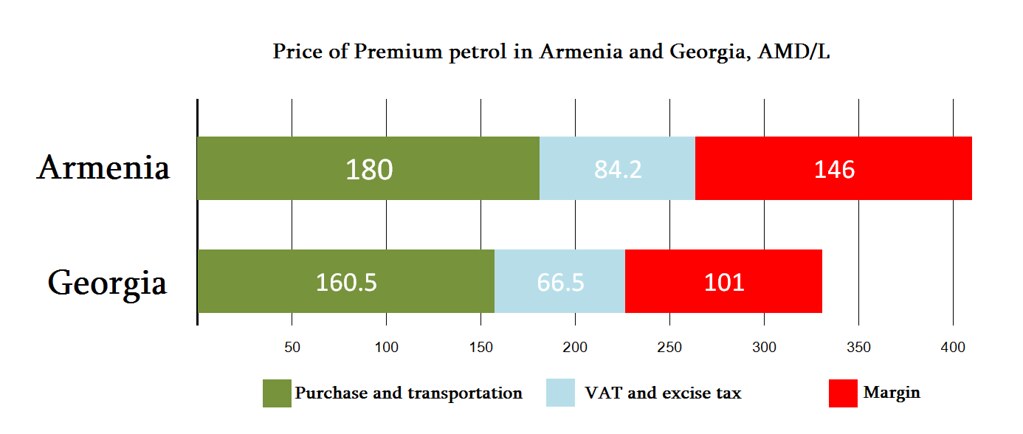
This fact does not answer a question but rather generates a new one: why is the margin so high in Armenia? In other words, why do the Armenian petrol market stakeholders have higher appetite?
The number of stakeholders may be one of the reasons – the greater their number, the higher the competitiveness at the market and the lower the prices.
Several companies are engaged in petrol import in Georgia: Lukoil imports it from Belarus, Wissol – from Greece, Rompetrol – from Romania, Gulf also imports petrol from European countries, SOCAR – from Azerbaijan.
As for Armenia, mainly two companies – Flash and CPS import petrol. It should be noted that they import petrol from newly founded Rosneft-Armenia Company, rather than directly from a seller. Rosneft imports petrol and diesel fuel from Russia and transfers them to these two companies on the Armenian-Georgian border.
Artak Shaboyan said that entrance to the market is unhampered, but it is unclear, why has the number of companies sharply dropped and Russia has become the only supplier. 5-6 companies acted at the market in 2006-2007, they imported petrol from different countries (including Bulgaria).
Gas factor
Perhaps, gas – the petrol’s competitor, is a key to the secret of its price. As a matter of fact, the petrol market is getting narrow. It could be clearly observed taking into consideration a drop in the volumes of petrol and diesel fuel, imported to Armenia.
According to the official data, over 400 thousand tons of petrol and diesel fuel were imported to Armenia in 2008. In 2014, import volumes were reduced to 325 thousand tons (data for 2015 are not available so far). According to officials-in-charge of the economic bloc of RA, “a shadow in this sphere has reduced in the recent years. In other words, a considerable part of the imported petrol was not registered documentarily several years ago, but the situation has changed now. It means that import and consequently, marketing, have actually reduced even more. As a result, profits of companies, dealing with petrol import and sale, have dropped.
Why? The answer can be found in a chart, showing how much gas Motor Gas Filling Stations (MGFS) annually consume in Armenia.
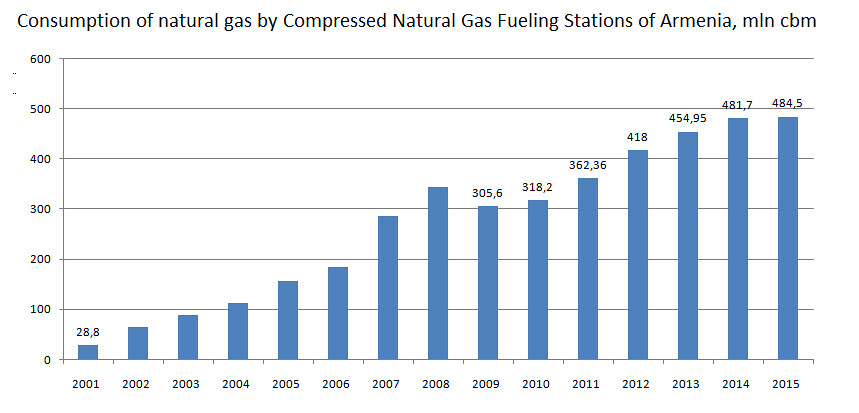
In 2015, MGFS sold 484,5 million cubic meters of gas. It should be noted for comparison that in 2009, 305,6 million cubic meters were consumed, in 2001- only 28,8 million cubic meters. Thus, annual consumption of gas per vehicle has increased by approximately 17 times in 15 years.
This is not a result of increase of the number of vehicle, it happened because more and more drivers refuse to use petrol from year to year and prefer gas. At present, over 70% of vehicle in Armenia consume natural gas. Notably, gas consumption has increased despite increase in its price. It means that even more expensive gas is more profitable for drivers than petrol.
To put it shortly, petrol is losing in a competition with gas in Armenia. At present, reduction of petrol consumption volumes resulted in decrease of the petrol market’s profits. It has reduced the profit so much that only 2-3 companies share the market instead of 5-6. These 2-3 companies try to maintain their profits at the expense of higher price.



















